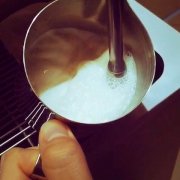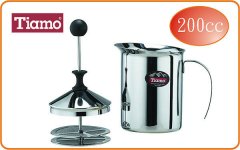The essential foaming skills of the coffee machine for baristas-from historical origins to hand-held tutorials on milk characteristics

Professional coffee knowledge exchange More coffee bean information Please pay attention to coffee workshop (Weixin Official Accounts cafe_style)
How to make fine foam Italian coffee making milk tips
This article has everything from historical origins to milk characteristics to hands-on tutorials. Please keep it and practice slowly:)
① Espresso coffee and milk perfect encounter
Espresso and milk are absolutely a natural combination. The former has fruity, caramel and chocolate flavors, while the latter is a healthy daily drink. The mixture of the two produces toffee, chocolate and dried fruit flavors. It is really a drink that you don't want to stop drinking. Espresso with milk is an ideal breakfast substitute for many people, providing the calories and essential minerals needed in the morning.
Espresso and milk pairings range from espresso shakes to milk bubbles or milk coats that are poured into cups to soften pure espresso. Today, coffee drinks served in cafes are actually mostly milk. Truth be told, some coffee chains are getting better at masking coffee flavors with scary amounts of milk and extra flavorings, usually sweeteners. But then again, even in boutique cafes, milk is important to the quality of the finished product, both as an elegant and delicate component of the drink and as an important intermediate in controlling the temperature of the drink.
Espresso isn't the beginning, much less the end. You might not think that humans have been mixing coffee and milk for about 300 years.
History: Coffee and milk intimate relationship
Coffee and milk (or cream) have always been natural partners. As early as the 18th century, people started putting them together. But it wasn't for the sake of its own taste; at the time, only children, the elderly and the sick drank it. For the same reason, mixed drinks of milk and tea also arose at the same time. Uncomfortable? Put some milk in your coffee! Later, creamy coffee was added, gradually creating a drink that went with casual sex.
In 1727, the English historian James Douglas wrote that many people hated the bitter taste of black coffee and preferred to "sweeten or milk it." Tristram Shandy, the hero of Lawrence Stern's comic novel of the same name published in the 1760s, was particularly fond of drinking "two cups of coffee milk," a drink he considered "well worth paying for." But milk and coffee must be boiled together, otherwise coffee is still coffee, milk is still milk."
Personally, I find boiled milk mostly unpalatable. Whether or not these early attempts invented latte coffee remains to be seen, and the perfect combination of coffee and milk did not really arrive until the mid-20th century when espresso machines came of age.
There are three reasons why milk and espresso machines make good friends. First, drinking milk for hydration and coffee for caffeine can be done simultaneously, saving time. A drink of warm milk and hot espresso can be drunk in a few sips and is a good mid-morning breakfast for those in a hurry. Second, milk cools drinks somewhat, especially traditional Italian lattes. In other words, you can drink a lot without worrying too much about burning your mouth. Third, the economic benefits are good. If a pocket of change can only be exchanged for a cup of 25 ml, just a little more caffeine and coffee-flavored things, no one is likely to be happy with it. But if you make this drink bigger, you can taste it slowly, and it will sell well. Coffee is no longer a fast-paced business of leaning on the bar, buying a cup and leaving, because coffee has been consumed for much longer. Coffee shops have also found business opportunities, selling snacks, cakes, doughnuts and other foods along with coffee. Espresso and milk drinks make everyone happy.
Different types of milk.
Milk is an emulsion of fat globules and a mixture of minerals, proteins, acids, sugars and salts. Whey protein and beta-lactoglobulin control fat globules and suspend them in water, making milk a stable substance. The mixing of fat and water makes milk opaque, and the refraction of light by the emulsion makes it appear blurred.
The milk you drink is almost certainly pasteurized. Pasteurization kills 99.999% of bacteria and extends the shelf life of milk products from 3 days to about 3 weeks. Standard pasteurization, or HTST, quickly heats milk to 72 ° C for 15 seconds to kill bacteria. Pasteurization certainly has its drawbacks. It destroys some of the whey protein in milk and reduces the mineral content.
"Long lasting milk" or ultra-high temperature sterilization (UHT) heats milk to an ultra-high temperature of 135 ° C for two seconds and cools it using high temperature steam jets and vacuum devices. UHT milk is popular in Europe (with the big exception of the UK), but I think it's far inferior to regular pasteurized milk.
Microfiltration separates the cream from milk and pasteurizes it separately. The thin whey can pass through the fine pores and the bacterial spores are filtered out, at which point the cream is mixed in. This disinfection method is slightly less effective at removing harmful bacteria, but most of the milk's natural mineral and protein content is retained.
Many milk brands are also homogenized. The fat molecules are broken down into smaller particles by baking and heating the flowing milk in tiny tubes. The protein in the milk immobilizes these particles and keeps them in emulsion. After these treatments, the milk becomes silky and smooth; although it tastes a little worse than unhomogenized milk, it no longer separates. I'm not that old yet, so I remember how bottled milk that wasn't homogenized often clogged the neck with creamy layering.
I've always liked to make cappuccinos, lattes and white coffees with whole milk. The high fat content makes the milk look silky and smooth and dense, and the taste is quite pronounced and more mellow. But that's the way things are. The best food is always accused of being bad for your health. For those worried about fat content, they can buy skim or semi-skim milk. I'd rather have one or two extra grams of dietary fat than compromise on quality.
sacrifice.
Whole milk contains 3.25 - 3.5% fat, skim milk contains about 1%. A standard latte requires about 150 milliliters of milk, meaning that lattes made with whole milk and skim milk have 5 grams and 1.5 grams of fat, respectively, a difference of 3.5 grams per cup. By analogy, a 150-gram packet of nuts contains 70 grams of fat, which is 20 times the difference between full-fat and nonfat lattes. And the latest research also shows that the less processed milk is, the healthier it is for the body, and it has nothing to do with fat content.
Some milk is naturally low-fat. Dairy cows in new Zealand are selectively fed so that milk directly from the udder is low fat milk with 1% fat. Conventional wisdom holds that fat is bad for you, and that a high-fat diet even raises the risk of heart disease, but some studies disagree and argue that the old wisdom is completely wrong.
③ Detailed explanation of the principle and steps of steaming milk (milk)
Properly steamed milk combines fine bubbles with warm liquid to create a sweet taste and light texture. Big coffee chains often overheated milk, which is really frustrating. The burning taste of coffee is evidence of overheated milk, or rather, milk tortured by heat squeals and rumbles loudly in the cup. Espresso drinks with milk shouldn't be too hot, but many stubborn coffee drinkers (especially in the UK) insist that their milk should reach magma temperature, regardless of how much flavor is lost. The temperature of drinking milk is not only related to the heat of taste perception, temperature is both creative and destructive, and it must be strictly controlled to maximize the natural sweetness of the finished product. It is also not difficult to process milk at the right temperature. Do not heat it above 70℃. Store it in a warm glass and drink it as soon as possible.
foam
Water and air are difficult to mix evenly under normal conditions and require surfactants to bind the two together. When whipped with a blender, the fat in the cream acts as a surfactant, and small bubbles and water form a whole with the rest of the cream. The air pumped into the mixture expands the fat in the cream and thickens it. As the creamy mix becomes lighter, the water becomes harder to run off.
Foaming is shaped (over time) by protein rather than fat, much as protein shapes protein creams. As soon as milk is heated, spring-like proteins begin to break down and denature.
Compared with cream and protein, milk protein can only barely maintain the foam form, so milk foam is usually thin and watery, easy to lose. The foam becomes lighter and lighter until it eventually becomes an ultralight cobweb structure floating on the surface of the liquid. This process begins with the end of steaming milk, so after a few minutes, the previously creamy cappuccino begins to layer and eventually becomes a light drink with milk and coffee on top. Many people find this "one layer of foam floating on top" cappuccino authentic. But I promise you, foam and coffee are perfect.
And "layered" cappuccino, without creating an embarrassing white beard when sipping, gives you more sensory enjoyment.
As mentioned above, the thicker the liquid, the less you have to worry about water loss, so whole milk foam is much stronger than skim milk. In addition, because skim milk has a low fat content, it does not inhibit the stability of protein foam, so it is easier to foam.
How to make milk
Milk must be kept in the refrigerator. Refrigerated milk has a longer shelf life, no doubt, and frothing with cold milk is much easier. The reason is simple: you have longer to "blow"(inject air) the milk before it reaches the default temperature.
The cup must be clean. The specific shape and size of the pull cup depends on personal preference. According to the law of heat absorption of metal, the thicker the pull cup, the slower it heats up. A clip-on temperature probe can be used to monitor the heating of the cup. Simple analog temperature probes work fine, but I prefer infrared probes that respond quickly and provide digital readings. As long as practice makes perfect, listening and observation alone (in fact, mainly listening) can grasp the temperature situation, and the probe will not be needed.
With the controlled injection of air, the milk begins to swirl and stretch violently, creating forces that cause tiny bubbles to break up in the milk and become suspended for a short time. Milk that is well mixed with air is often referred to as "micro-bubbles" because bubbles are so tightly integrated with the milk that they are completely invisible to the naked eye. The milk now looks thicker and creamier. Never reheat milk, or the reheated protein won't work and the taste will deteriorate.
The following steps show you how to use the espresso machine accessory steam wand to frother milk in a sipping cup and how to heat milk to the desired temperature.
Pour the milk into the cup, at least half full. Be sure not to reheat milk, so add as much as you need.
② Clean the steam stick of the espresso machine and drain the residual condensed water.
③ Ensure that the tip of the steam stick is just inserted into the milk surface and starts at full power. If the amount of milk is very small, it can be reduced slightly.
Low power.
④ Start foaming, control the direction of steam flow along the inner circumference of the flower cup, and make the milk swirl.
640-4
Increase the amount of steam supply, pull the tip of the steam stick to the surface of the milk, in addition to the noise of milk agitation, you should also hear a sharp "pop sound". No large bubbles should be visible at this point.
Continue to spin the milk and foam. Once it gets to 40 ° C, free-flowing fat comes to the fore and milk is hard to beat.
Insert the steam wand deeply into the milk and continue to rotate the left hand until 65℃.
Turn off the steam wand immediately.
Gently tap the flower cup to crack the foam on the surface.
Rotate the milk bubbles quickly and forcefully in a circular track, so that the air, water and milk are fully combined and quickly poured into the coffee.
。
Important Notice :
前街咖啡 FrontStreet Coffee has moved to new addredd:
FrontStreet Coffee Address: 315,Donghua East Road,GuangZhou
Tel:020 38364473
- Prev

Experience of foam-making skills of steam coffee machine
Professional coffee knowledge exchange more coffee bean information please pay attention to the coffee workshop (Wechat official account cafe_style) how to play the delicate milk foam espresso skills recently the milk foam technology has been a bit more stable, although the pull flower is still 2266, but it feels that as long as the milk foam is hit well, the chances of success (or can be seen) will be higher, so milking
- Next

How to beat milk foam without tools? how to beat milk foam with egg beater?
Professional coffee knowledge exchange more coffee bean information please follow the coffee workshop (Wechat official account cafe_style) how to use delicate milk foam espresso skills I think supermarkets sell bubblers, less than a hundred? Or there is a pot that makes scented tea at home (after the glass scented tea is boiled, the lid of the pot is made of stainless steel and the tea leaves are squeezed down), microwave heat the milk for seven minutes.
Related
- What is the meaning of lactic acid fermentation with coffee bean treatment?
- How to judge the state of foam by sound?
- How does the latte pull out the unicorn pattern? Come to get for a little trick to improve the flower pull!
- Will flower pulling affect the taste of the latte?
- Do you know the history of coffee?
- The difference between honey treatment and sun washing what is raisin honey treatment?
- What kind of milk can a novice use to make coffee foam to keep the foam longer? The correct method and skills of milking tutorial sharing
- Why do washed coffee beans taste sour? Flavor characteristics of washed Coffee
- Introduction to the skill of how to practice the size and height of water injection around the circle of hand-brewed coffee
- How do beginners practice coffee flower drawing from scratch?

